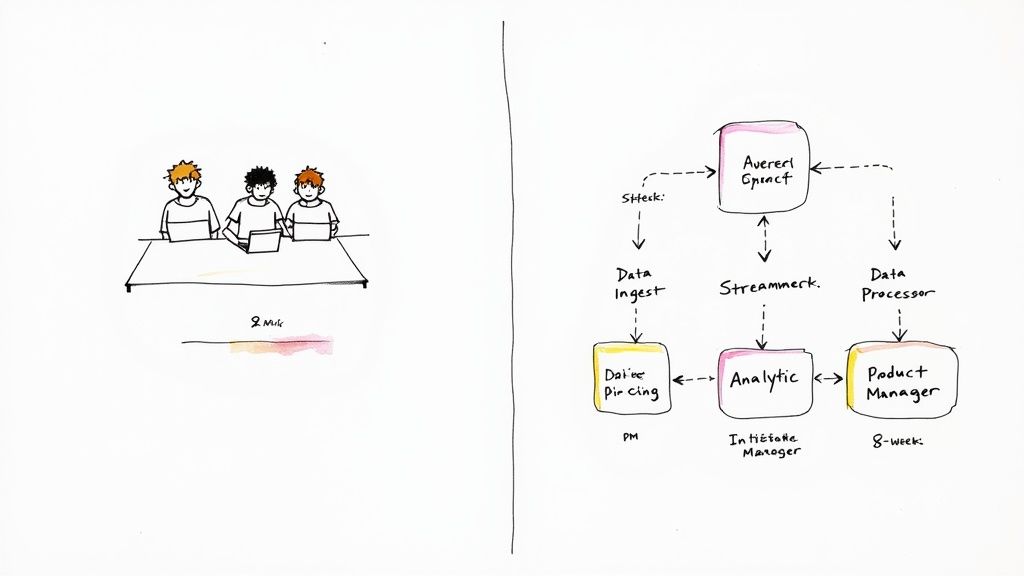TL;DR
- What it is: Nearshore software development is outsourcing to expert teams in neighboring countries with similar time zones (e.g., a US company partnering with engineers in Mexico).
- Why it works: It balances cost, talent access, and real-time collaboration. Time zone overlap (0–3 hours) eliminates the communication lag common with offshore teams.
- Who it's for: CTOs, Founders, and Product Leads who need to hire specialized AI/ML talent and launch projects in weeks, not months.
- Recommended Action: Start with a 2–4 week pilot project to validate technical skills, communication, and cultural fit before making a long-term commitment.
Who Is This For?
We wrote this guide for the leaders who make decisions about talent and technology and need to deliver results, fast.
This is for you if you're a:
- CTO or Head of Engineering trying to scale your team and hit ambitious roadmap goals without compromising quality or budget.
- Founder or Product Lead scoping new AI features and needing a realistic plan for the talent and costs required to build them.
- Talent Ops or Procurement Leader responsible for vetting reliable partners and de-risking the process of hiring specialized tech talent.
If you're under pressure to launch a critical AI pilot in the next 4–6 weeks or struggling to find local MLOps engineers, this guide provides a practical playbook.
The Quick Answer: When to Choose Nearshore
Nearshore development is the optimal choice when you need a strategic blend of speed, specialized talent, and cost-efficiency. It’s ideal for complex, agile projects that require daily collaboration.
Use this decision tree to determine the best outsourcing model for your situation.

As the diagram shows, nearshore hits the sweet spot for high-stakes projects where you can't afford to compromise on real-time communication or skill level.
2 Practical Examples of Nearshore Teams in Action
Theory is one thing, but real-world execution shows how nearshore development accelerates roadmaps. Here are two common scenarios.
Example 1: Launching an AI Feature in Eight Weeks
A mid-sized SaaS company needed to build a Retrieval-Augmented Generation (RAG) feature for its customer support platform. Their in-house team lacked the niche AI and MLOps skills to build it quickly.
- Team Composition: They onboarded a nearshore team of two Senior AI Engineers and one MLOps Engineer.
- Collaboration Cadence: The team integrated directly into the company's agile process, joining daily stand-ups via Slack huddles and bi-weekly sprint planning on Zoom. The minimal time-zone difference meant no communication delays.
- Business Impact: The team delivered a production-ready RAG feature in just eight weeks. This allowed the company to launch a high-demand feature a full quarter ahead of schedule, directly improving user retention.
Example 2: Building a Real-Time Analytics Pipeline
A fintech startup needed a sophisticated data pipeline to power a real-time analytics dashboard. The project required deep expertise in data streaming technologies that were difficult to find locally.
They used a nearshore team to build the backend architecture, allowing their in-house team to focus on the user experience.

As the architecture shows, the nearshore team owned data ingestion and processing with tools like Kafka and Spark. This hybrid model allowed each team to focus on its strengths, enabling the startup to launch its analytics feature on time and under budget.
The Deep Dive: Trade-Offs, Alternatives, and Pitfalls
Nearshore development is a powerful model, but success requires navigating its trade-offs. The primary alternatives are onshore (local) and offshore (distant) development.
This comparison table breaks down the key differences.
Common Pitfalls and How to Avoid Them
Success depends on avoiding common mistakes.
1. Misaligned Expectations and Vague Scope
The fastest way to derail a project is a poorly defined scope.
- The Fix: Invest time upfront in a detailed Statement of Work (SOW). Define deliverables, acceptance criteria, and communication cadences (e.g., daily stand-ups on Slack, bi-weekly planning in Jira). Clearly state that all intellectual property (IP) belongs to your company.
2. Overlooking Cultural Nuances
Even with small time-zone differences, communication styles can vary.
- The Fix: Be intentional about creating a single, integrated team culture. At kickoff, establish clear norms for giving feedback, handling disagreements, and celebrating wins. This is a key advantage of nearshoring to Latin America, where business etiquette often aligns closely with North America. This cultural affinity smooths collaboration, a point noted in many top nearshore software development trends on teravisiontech.com.
Choosing the right model depends on your project's specific needs. While offshore offers the lowest cost and onshore provides maximum convenience, nearshore delivers the most balanced strategic value. For a deeper look, see our guide on IT outsourcing development.

Business Impact: The primary benefit is accelerated time-to-market. Instead of a six-month search for one AI engineer, you can launch a pilot with a vetted nearshore expert in two weeks. This speed allows you to test ideas, refine products, and outmaneuver competitors. It's no surprise a Bloomberg report found that 80% of North American companies are exploring nearshore options.
Checklist: How to Launch a Nearshore Team
Building a high-performing nearshore team requires a structured process. A reliable partner is critical—vet them by asking for a detailed breakdown of their technical screening process for senior AI engineers.
For a full framework on partner evaluation, read our guide on choosing a staff augmentation company.
Use this checklist to manage the process from preparation to ongoing success.
A methodical approach is what separates teams that thrive from those that struggle. For more details, explore this complete playbook for hiring remote software developers.

What To Do Next
You have the framework. The next step is to apply it to your project and see how this model can accelerate your roadmap.
- Define Your Scope: Book a 20-minute scoping call with us. We'll help you pinpoint the exact engineering and AI skills your project demands.
- Meet Your Candidates: Within 48 hours, you'll receive a curated list of pre-vetted AI engineers who match your requirements.
- Launch a Pilot: Start with a no-risk 2–4 week pilot project. It’s the best way to validate skills and team fit before making a long-term commitment.
Ready to build your team? Start Your Pilot or See Sample Profiles.
References & Further Reading
For more information on the topics discussed, please refer to the following sources.
- Bloomberg Professional Services on nearshoring trends.
- DeskCove on leveraging specialized outsourcing companies.
- Teravision Technologies on nearshore software development trends.
- ThirstySprout's guide to IT outsourcing development.
- Remote First Jobs' playbook on hiring remote developers.
Ready to build your high-performing remote AI team? ThirstySprout provides pre-vetted, senior AI and software engineering talent that integrates seamlessly with your time zone and workflow.
Hire from the Top 1% Talent Network
Ready to accelerate your hiring or scale your company with our top-tier technical talent? Let's chat.

